Doctor Who: The Seeds Of Death, Part 5
 The 236th episode of Doctor Who airs on the BBC. This is the second appearance of the Ice Warriors.
The 236th episode of Doctor Who airs on the BBC. This is the second appearance of the Ice Warriors.
More about Doctor Who in the LogBook
Order VWORP!1 from theLogBook.com Store
 The 236th episode of Doctor Who airs on the BBC. This is the second appearance of the Ice Warriors.
The 236th episode of Doctor Who airs on the BBC. This is the second appearance of the Ice Warriors.
More about Doctor Who in the LogBook
Order VWORP!1 from theLogBook.com Store
 ABC airs the 19th episode of Irwin Allen’s sci-fi series Land Of The Giants, starring Gary Conway, Don Matheson, Deanna Lund, and Don Marshall. Kevin Hagan guest stars.
ABC airs the 19th episode of Irwin Allen’s sci-fi series Land Of The Giants, starring Gary Conway, Don Matheson, Deanna Lund, and Don Marshall. Kevin Hagan guest stars.
More about Land Of The Giants in the LogBook and theLogBook.com Store
Land Of The Giants now streaming on Amazon Prime
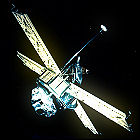 NASA and JPL launch the unmanned Mariner 6 space probe on a mission to Mars, where it will be joined by its yet-to-be-launched identical twin, Mariner 7. Mariner 6 will take five months to reach the red planet, with its slightly faster sister ship mere days behind it, and will fly past Mars twice as close as the planet’s previous unmanned visitors.
NASA and JPL launch the unmanned Mariner 6 space probe on a mission to Mars, where it will be joined by its yet-to-be-launched identical twin, Mariner 7. Mariner 6 will take five months to reach the red planet, with its slightly faster sister ship mere days behind it, and will fly past Mars twice as close as the planet’s previous unmanned visitors.
 BBC2 airs the 34th episode of science fiction anthology series Out Of The Unknown. Adapted by Julian Bond from a story by C.M. Kornbluth, the story stars Emrys Jones and Geraldine Moffatt.
BBC2 airs the 34th episode of science fiction anthology series Out Of The Unknown. Adapted by Julian Bond from a story by C.M. Kornbluth, the story stars Emrys Jones and Geraldine Moffatt.
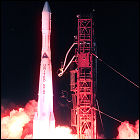 The recently-rechristened Environmental Sciences Service Administration launches, with the help of NASA, ESSA-9, the latest in a constellation of weather satellites. ESSA-9 is the last weather satellite to carry the ESSA designation, as the government reorganizes ESSA into a new agency, NOAA, the following year. ESSA-9 remains in service until 1972.
The recently-rechristened Environmental Sciences Service Administration launches, with the help of NASA, ESSA-9, the latest in a constellation of weather satellites. ESSA-9 is the last weather satellite to carry the ESSA designation, as the government reorganizes ESSA into a new agency, NOAA, the following year. ESSA-9 remains in service until 1972.
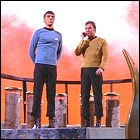 The 76th episode of Gene Roddenberry’s science fiction series Star Trek airs on NBC. Jeff Corey guest stars.
The 76th episode of Gene Roddenberry’s science fiction series Star Trek airs on NBC. Jeff Corey guest stars.
 The 237th episode of Doctor Who airs on the BBC. This is the second appearance of the Ice Warriors.
The 237th episode of Doctor Who airs on the BBC. This is the second appearance of the Ice Warriors.
More about Doctor Who in the LogBook
Order VWORP!1 from theLogBook.com Store
 ABC airs the 20th episode of Irwin Allen’s sci-fi series Land Of The Giants, starring Gary Conway, Don Matheson, Deanna Lund, and Don Marshall. Arthur Franz guest stars.
ABC airs the 20th episode of Irwin Allen’s sci-fi series Land Of The Giants, starring Gary Conway, Don Matheson, Deanna Lund, and Don Marshall. Arthur Franz guest stars.
More about Land Of The Giants in the LogBook and theLogBook.com Store
Land Of The Giants now streaming on Amazon Prime
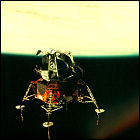 Apollo 9 lifts off on a ten-day mission to test the first lunar lander, but only in Earth orbit. Jim McDivitt and Rusty Schweickart put the lunar module, nicknamed Spider, through its paces, while David Scott mans the command module Gumdrop. This is the first flight of the completely non-aerodynamic lunar module, and various docking maneuvers and spacewalk scenarios are practiced. The crew returns to Earth in the Apollo command module, while Spider is left in a low orbit which decays two weeks later, allowing it to disintegrate in Earth’s atmosphere.
Apollo 9 lifts off on a ten-day mission to test the first lunar lander, but only in Earth orbit. Jim McDivitt and Rusty Schweickart put the lunar module, nicknamed Spider, through its paces, while David Scott mans the command module Gumdrop. This is the first flight of the completely non-aerodynamic lunar module, and various docking maneuvers and spacewalk scenarios are practiced. The crew returns to Earth in the Apollo command module, while Spider is left in a low orbit which decays two weeks later, allowing it to disintegrate in Earth’s atmosphere.
This mission is dramatized in the Spider episode of HBO’s 1998 series From The Earth To The Moon.
 BBC2 airs the 34th episode of science fiction anthology series Out Of The Unknown. Written by Brian Hayles (creator of Doctor Who’s Ice Warriors), the story stars Bernard Horsfall and Geoffrey Palmer. This episode no longer exists in the BBC’s archives.
BBC2 airs the 34th episode of science fiction anthology series Out Of The Unknown. Written by Brian Hayles (creator of Doctor Who’s Ice Warriors), the story stars Bernard Horsfall and Geoffrey Palmer. This episode no longer exists in the BBC’s archives.
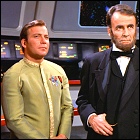 The 77th episode of Gene Roddenberry’s science fiction series Star Trek airs on NBC. Lee Bergere and Barry Atwater guest star. This episode features the last Klingon seen in the original series.
The 77th episode of Gene Roddenberry’s science fiction series Star Trek airs on NBC. Lee Bergere and Barry Atwater guest star. This episode features the last Klingon seen in the original series.
 The 238th episode of Doctor Who airs on the BBC. This is the second story written by Robert Holmes, and is the most recent Doctor Who story to be missing entire episodes from the BBC’s archives.
The 238th episode of Doctor Who airs on the BBC. This is the second story written by Robert Holmes, and is the most recent Doctor Who story to be missing entire episodes from the BBC’s archives.
More about Doctor Who in the LogBook
Order VWORP!1 from theLogBook.com Store
 ABC airs the 21st episode of Irwin Allen’s sci-fi series Land Of The Giants, starring Gary Conway, Don Matheson, Deanna Lund, and Don Marshall. Ron Howard guest stars.
ABC airs the 21st episode of Irwin Allen’s sci-fi series Land Of The Giants, starring Gary Conway, Don Matheson, Deanna Lund, and Don Marshall. Ron Howard guest stars.
More about Land Of The Giants in the LogBook and theLogBook.com Store
Land Of The Giants now streaming on Amazon Prime
 BBC2 airs the 35th episode of science fiction anthology series Out Of The Unknown. Written by Michael Ashe, the story stars Richard Pearson and Freda Bamford. This episode no longer exists in the BBC’s archives.
BBC2 airs the 35th episode of science fiction anthology series Out Of The Unknown. Written by Michael Ashe, the story stars Richard Pearson and Freda Bamford. This episode no longer exists in the BBC’s archives.
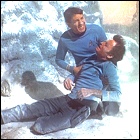 The 78th episode of Gene Roddenberry’s science fiction series Star Trek airs on NBC. Ian Wolfe and Mariette Hartley guest star. The last episode of Star Trek is aired months later with little fanfare.
The 78th episode of Gene Roddenberry’s science fiction series Star Trek airs on NBC. Ian Wolfe and Mariette Hartley guest star. The last episode of Star Trek is aired months later with little fanfare.
 The 239th episode of Doctor Who airs on the BBC. This is the second story written by Robert Holmes. Part 2 is the only intact episode of this story remaining in the BBC’s archives.
The 239th episode of Doctor Who airs on the BBC. This is the second story written by Robert Holmes. Part 2 is the only intact episode of this story remaining in the BBC’s archives.
More about Doctor Who in the LogBook
Order VWORP!1 from theLogBook.com Store
 ABC airs the 22nd episode of Irwin Allen’s sci-fi series Land Of The Giants, starring Gary Conway, Don Matheson, Deanna Lund, and Don Marshall. Jack Albertson guest stars.
ABC airs the 22nd episode of Irwin Allen’s sci-fi series Land Of The Giants, starring Gary Conway, Don Matheson, Deanna Lund, and Don Marshall. Jack Albertson guest stars.
More about Land Of The Giants in the LogBook and theLogBook.com Store
Land Of The Giants now streaming on Amazon Prime
 BBC2 airs the 36th episode of science fiction anthology series Out Of The Unknown. Adapted by Clive Exton from a story by Clifford D. Simak, this script was previously used in the 1962 anthology series Out Of This World. This episode no longer exists in the BBC’s archives.
BBC2 airs the 36th episode of science fiction anthology series Out Of The Unknown. Adapted by Clive Exton from a story by Clifford D. Simak, this script was previously used in the 1962 anthology series Out Of This World. This episode no longer exists in the BBC’s archives.
 The 240th episode of Doctor Who airs on the BBC. This is the second story written by Robert Holmes, and is the most recent Doctor Who story to be missing entire episodes from the BBC’s archives.
The 240th episode of Doctor Who airs on the BBC. This is the second story written by Robert Holmes, and is the most recent Doctor Who story to be missing entire episodes from the BBC’s archives.
More about Doctor Who in the LogBook
Order VWORP!1 from theLogBook.com Store
 ABC airs the 23rd episode of Irwin Allen’s sci-fi series Land Of The Giants, starring Gary Conway, Don Matheson, Deanna Lund, and Don Marshall. Lee Meriwether guest stars.
ABC airs the 23rd episode of Irwin Allen’s sci-fi series Land Of The Giants, starring Gary Conway, Don Matheson, Deanna Lund, and Don Marshall. Lee Meriwether guest stars.
More about Land Of The Giants in the LogBook and theLogBook.com Store
Land Of The Giants now streaming on Amazon Prime
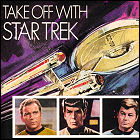 Having completed its purchase of Desilu Studios, Paramount runs the first print advertisement in Vol. 76, Issue 12 of Broadcasting Magazine, offering Star Trek reruns in syndication. Even though the last episode has yet to air on NBC, it is perhaps telling that the ad promises a set number of “79 episodes of constant quality, now being seen in over 65 countries around the world” – confirmation that there will be no further episodes beyond the current season.
Having completed its purchase of Desilu Studios, Paramount runs the first print advertisement in Vol. 76, Issue 12 of Broadcasting Magazine, offering Star Trek reruns in syndication. Even though the last episode has yet to air on NBC, it is perhaps telling that the ad promises a set number of “79 episodes of constant quality, now being seen in over 65 countries around the world” – confirmation that there will be no further episodes beyond the current season.
 NASA and JPL launch the unmanned Mariner 7 space probe on a mission to Mars, where it will be joined by its recently-launched identical twin, Mariner 6. Mariner 7 will take five months to reach the red planet, but on a slightly faster trajectory it will arrive just days behind Mariner 6. Both will fly past Mars twice as close as the planet’s previous unmanned visitors.
NASA and JPL launch the unmanned Mariner 7 space probe on a mission to Mars, where it will be joined by its recently-launched identical twin, Mariner 6. Mariner 7 will take five months to reach the red planet, but on a slightly faster trajectory it will arrive just days behind Mariner 6. Both will fly past Mars twice as close as the planet’s previous unmanned visitors.
 The 241st episode of Doctor Who airs on the BBC. This is the second story written by Robert Holmes, and is the most recent Doctor Who story to be missing entire episodes from the BBC’s archives.
The 241st episode of Doctor Who airs on the BBC. This is the second story written by Robert Holmes, and is the most recent Doctor Who story to be missing entire episodes from the BBC’s archives.
More about Doctor Who in the LogBook
Order VWORP!1 from theLogBook.com Store
 ABC airs the 24th episode of Irwin Allen’s sci-fi series Land Of The Giants, starring Gary Conway, Don Matheson, Deanna Lund, and Don Marshall. Robert Colbert (The Time Tunnel) guest stars.
ABC airs the 24th episode of Irwin Allen’s sci-fi series Land Of The Giants, starring Gary Conway, Don Matheson, Deanna Lund, and Don Marshall. Robert Colbert (The Time Tunnel) guest stars.
More about Land Of The Giants in the LogBook and theLogBook.com Store
Land Of The Giants now streaming on Amazon Prime
 BBC2 airs the 38th episode of science fiction anthology series Out Of The Unknown. Adapted by David Climie from a story by Peter Phillips, the story stars Peter Barkworth and features an appearance by the Daleks (complete with David Graham providing their voices) from the series’ BBC stablemate, Doctor Who. Directed by Peter Cregeen, a future BBC Head of Series who would become infamous for cancelling Doctor Who after its 1989 season, this episode closes the third season, but no longer exists in the BBC’s archives.
BBC2 airs the 38th episode of science fiction anthology series Out Of The Unknown. Adapted by David Climie from a story by Peter Phillips, the story stars Peter Barkworth and features an appearance by the Daleks (complete with David Graham providing their voices) from the series’ BBC stablemate, Doctor Who. Directed by Peter Cregeen, a future BBC Head of Series who would become infamous for cancelling Doctor Who after its 1989 season, this episode closes the third season, but no longer exists in the BBC’s archives.
More about Out Of The Unknown in the LogBook
Hear about it on the Sci-Fi 5 podcast
 The 242nd episode of Doctor Who airs on the BBC. This is the second story written by Robert Holmes, and is the most recent Doctor Who story to be missing entire episodes from the BBC’s archives.
The 242nd episode of Doctor Who airs on the BBC. This is the second story written by Robert Holmes, and is the most recent Doctor Who story to be missing entire episodes from the BBC’s archives.
More about Doctor Who in the LogBook
Order VWORP!1 from theLogBook.com Store
 This is the observed day of the internet’s birth, actually marking the day that the Defense Advanced Research Projects Agency chose the contractor to build the initial nodes and connections of the ARPAnet. Though the internet is ubiquitous from a 21st century perspective, its origins lie in a disquieting Cold-War-era concept of a distributed computer communications network whose operations could continue even if multiple nodes of the network have been disrupted or destroyed. ARPAnet, the forerunner to the modern internet, will become operational on an experimental basis later in 1969.
This is the observed day of the internet’s birth, actually marking the day that the Defense Advanced Research Projects Agency chose the contractor to build the initial nodes and connections of the ARPAnet. Though the internet is ubiquitous from a 21st century perspective, its origins lie in a disquieting Cold-War-era concept of a distributed computer communications network whose operations could continue even if multiple nodes of the network have been disrupted or destroyed. ARPAnet, the forerunner to the modern internet, will become operational on an experimental basis later in 1969.
 The 243rd episode of Doctor Who airs on the BBC. This is the second story written by Robert Holmes, and is the most recent Doctor Who story to be missing entire episodes from the BBC’s archives.
The 243rd episode of Doctor Who airs on the BBC. This is the second story written by Robert Holmes, and is the most recent Doctor Who story to be missing entire episodes from the BBC’s archives.
More about Doctor Who in the LogBook
Order VWORP!1 from theLogBook.com Store
 ABC airs the 25th episode of Irwin Allen’s sci-fi series Land Of The Giants, starring Gary Conway, Don Matheson, Deanna Lund, and Don Marshall.
ABC airs the 25th episode of Irwin Allen’s sci-fi series Land Of The Giants, starring Gary Conway, Don Matheson, Deanna Lund, and Don Marshall.
More about Land Of The Giants in the LogBook and theLogBook.com Store
Land Of The Giants now streaming on Amazon Prime
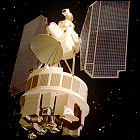 NASA launches the Nimbus 3 satellite, designed to observe weather patterns from orbit and test new weather and climate detection technologies. Nimbus 3 is the first Earth-orbiting spacecraft to test the SNAP-19 radioisotope thermoelectric generator system; devices similar to the SNAP-19 will become the primary power source for later deep space and outer solar system interplanetary missions. Nimbus 3 loses attitude control in 1970, but is kept online for engineering information-gathering purposes until 1972.
NASA launches the Nimbus 3 satellite, designed to observe weather patterns from orbit and test new weather and climate detection technologies. Nimbus 3 is the first Earth-orbiting spacecraft to test the SNAP-19 radioisotope thermoelectric generator system; devices similar to the SNAP-19 will become the primary power source for later deep space and outer solar system interplanetary missions. Nimbus 3 loses attitude control in 1970, but is kept online for engineering information-gathering purposes until 1972.